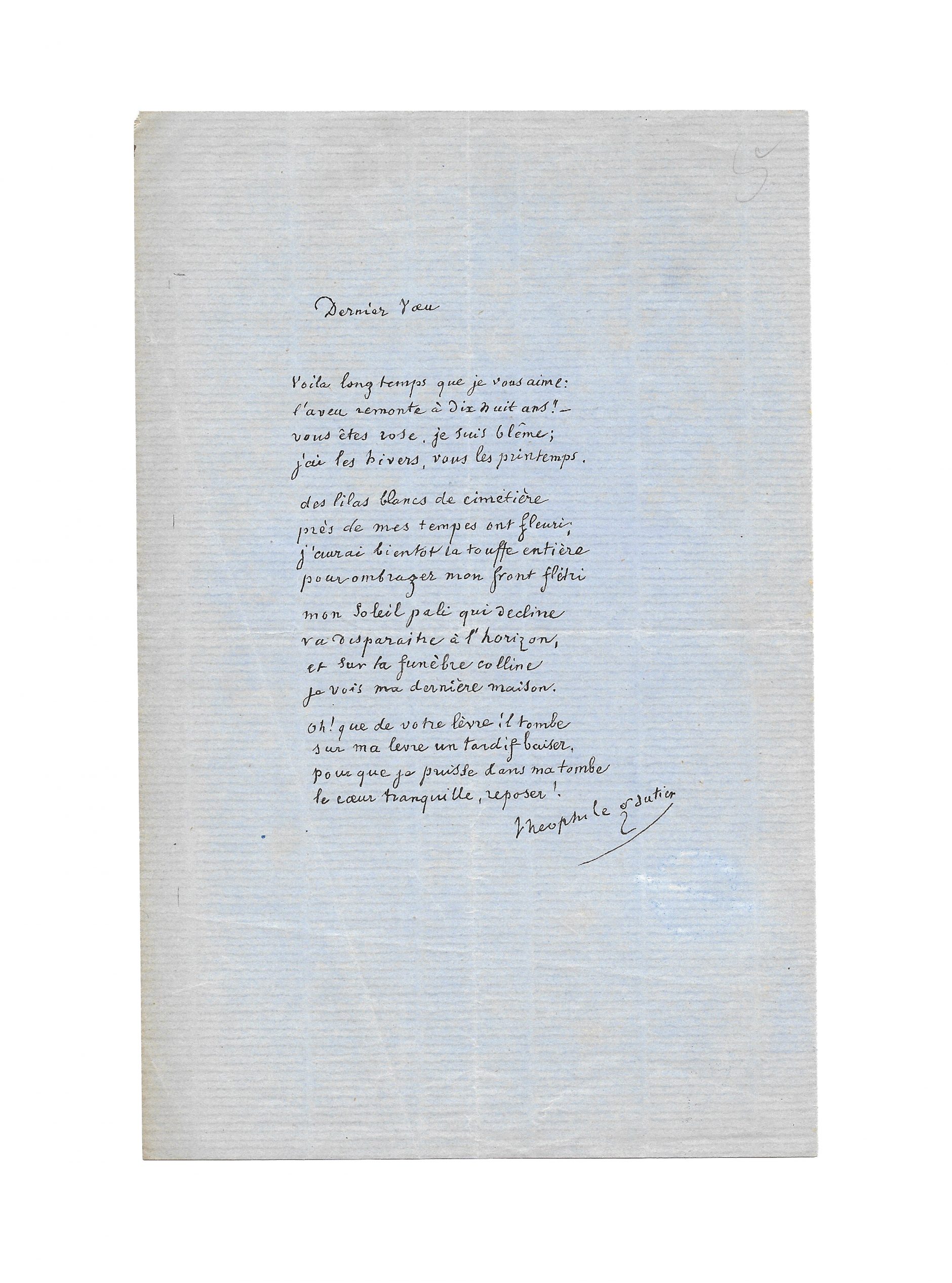GAUTIER, Théophile (1811-1872)
Autograph poem signed « Théophile Gautier »
[N.p.n.d], 1 p. in-8° in black ink on blue laid paper
« And on the mournful, doleful hill / I see my final dwelling-place »
Fact sheet
GAUTIER, Théophile (1811-1872)
Autograph poem signed « Théophile Gautier »
[N.p.n.d], 1 p. in-8° in black ink on blue laid paper
Old stamp residue, tiny missing bit on top right angle, fold marks
Famous poem from his collection Enamels and Cameos, the pinnacle of the romantic aesthetic that prefigures the Parnassism movement
« Denier vœu
Voilà longtemps que je vous aime :
L’aveu remonte à dix-huit ans ! –
Vous êtes rose, je suis blême ;
J’ai les hivers, vous les printemps.
Des lilas blancs de cimetière
Prés de mes tempes ont fleuri,
J’aurai bientôt la touffe entière
Pour ombrager mon front flétri
Mon soleil pâli qui décline
Va disparaître à l’horizon,
Et sur la funèbre colline
Je vois ma dernière maison.
Oh ! que de votre lèvre il tombe
Sur ma lèvre un tardif baiser,
Pour que je puisse dans ma tombe
Le cœur tranquille, reposer !
Théophile Gautier »
[English translation]
“Last Wish” is the thirty-second of the thirty-seven poems that make up the collection Enamels and Cameos, which remains the poet’s most famous. Like most other poems, “Last Wish” is constructed of octosyllabic verses in crossed rhymes. If the celebration of spring and death hangs over the whole collection, it is more present here than ever.
Although the first pieces are part of the romantic aesthetic, the essence of the Parnassism conception of the poet evolves as publications progress, there are indeed no less than five between 1852 and 1872.
Manifesto of Art for Art Prefiguring Parnassism
Enamels and Cameos is part of the manifestos of Art for Art’s sake: the cult of beauty, the perfection of form guide the poet, who chooses to retain from the world only the fleeting visions of grace that he glimpses, even through death.
Gautier, the “impeccable poet”
Although Parnassism strives to keep this promise of Art for art’s sake, Gautier intends to put to work in his poetry a sensitivity like no other. The secret and dreamy man, a wonderful distiller of pure poetry, then leads a passionate quest for perfection. He was admired by the great poets of his time such as Mallarmé or Baudelaire; the latter, in his inscription of The Flowers of Evil, describes him as “perfect magician of French letters” and “impeccable poet”. He also conquered Wilde, across the Channel, and the musicians Berlioz, Gounod and Fauré, who made Enamels and Cameos famous by setting texts to music.
Autograph poems from the collection Enamels and Cameos are very scarce
References:
Œuvres poétiques complètes, éd. Michel Brix, Bartillat, p. 564
Correspondance générale, éd. Pierre Laubriet, Librairie Droz, p. 233 et 239
Émaux et Camées, éd. Gothot-Mersch, Gallimard, p. 142
